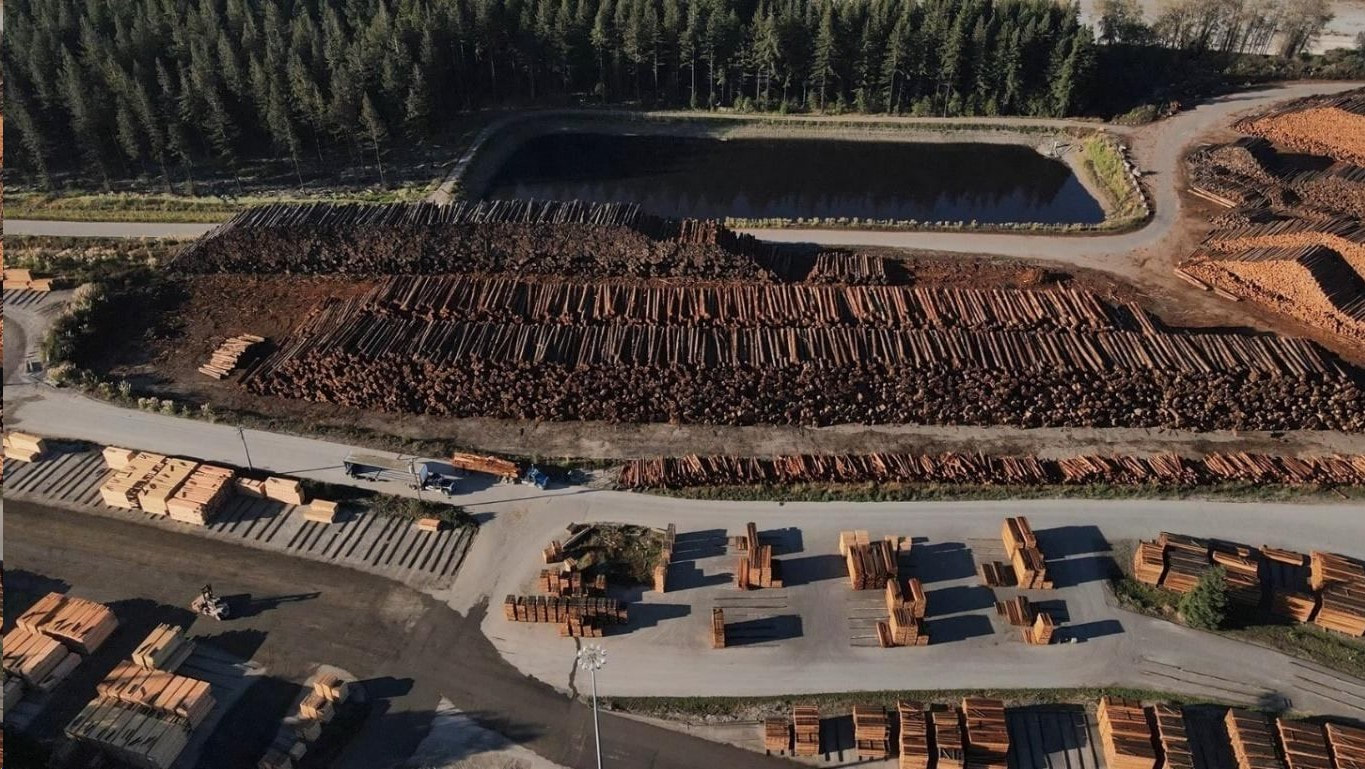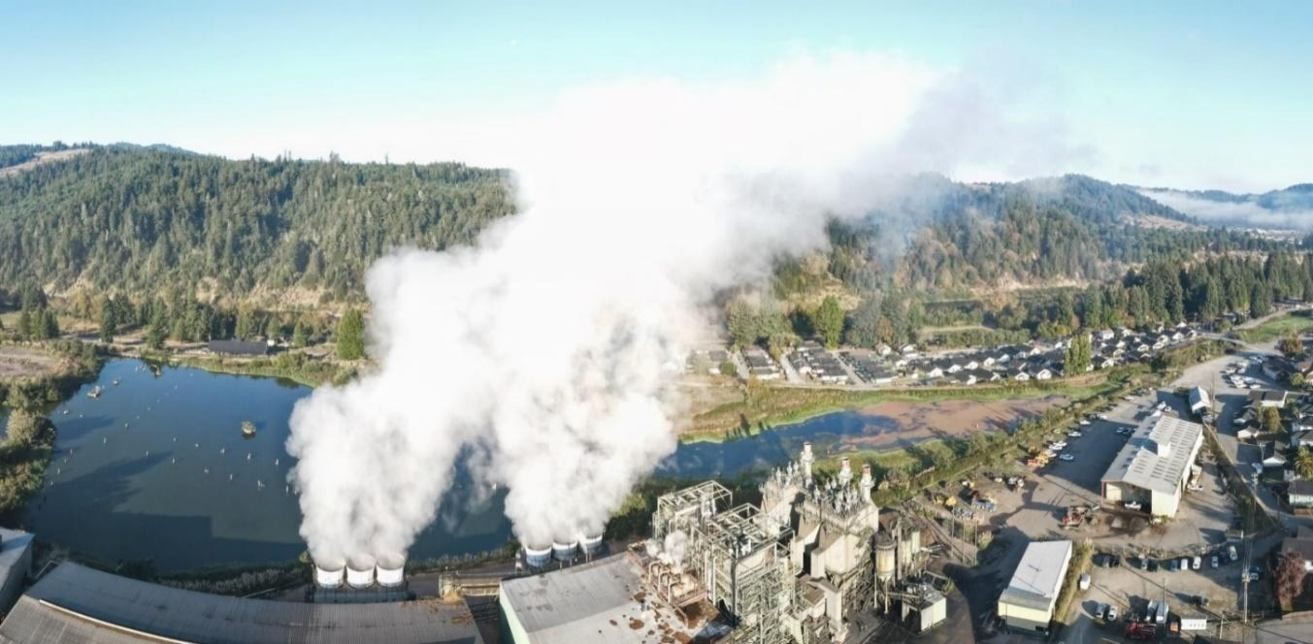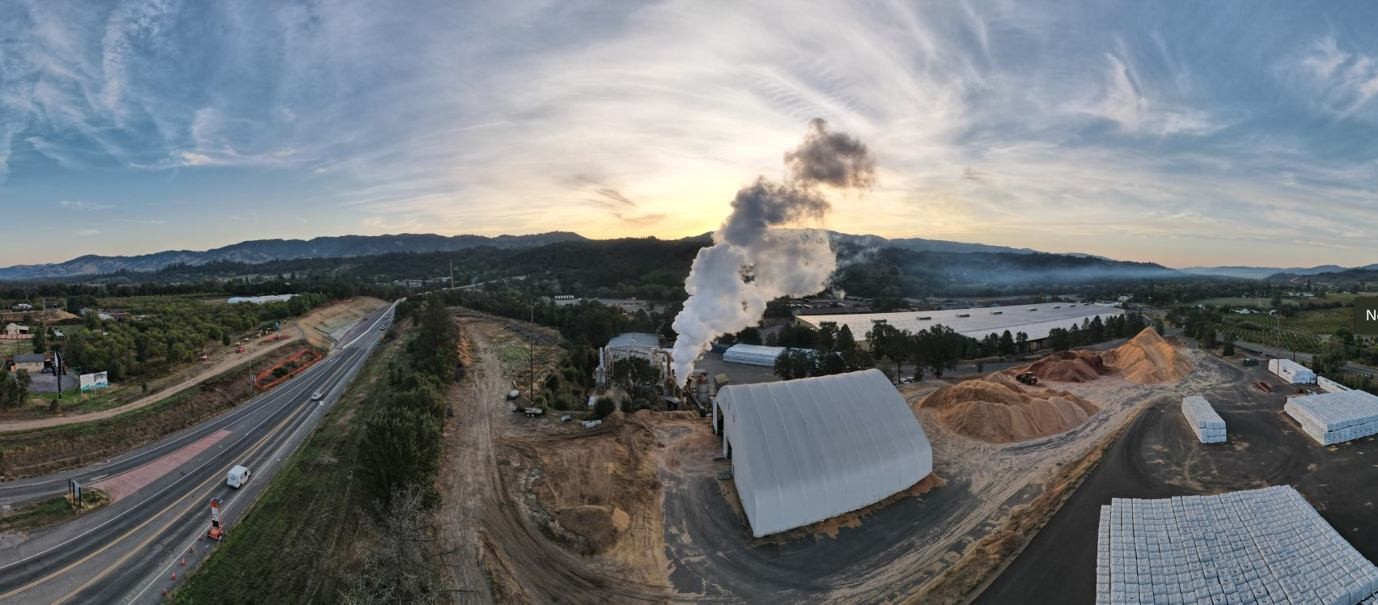Biomass Power Basics
| |||||||
Protect Homes and Forests
Say NO to Biomass Energy
● The most effective way to protect homes from fire:
- Home hardening
- Creation of defensible space up to 100 feet
● Our forests are being targeted for extraction in the name of fire resilience
- Clearing trees beyond 100 feet can exacerbate the spread of wind-driven fires
- Causes immense damage to forest ecosystems, and worsens the climate crisis
● Biomass energy is being touted as a way to use wood "waste"/slash resulting from all the cutting
- Biomass energy uses whole trees and is highly polluting
- Serious health impacts disproportionately affect low- income communities
- Not renewable!
- Not carbon neutral; will only exacerbate our climate crisis
- Home hardening
- Creation of defensible space up to 100 feet
● Our forests are being targeted for extraction in the name of fire resilience
- Clearing trees beyond 100 feet can exacerbate the spread of wind-driven fires
- Causes immense damage to forest ecosystems, and worsens the climate crisis
● Biomass energy is being touted as a way to use wood "waste"/slash resulting from all the cutting
- Biomass energy uses whole trees and is highly polluting
- Serious health impacts disproportionately affect low- income communities
- Not renewable!
- Not carbon neutral; will only exacerbate our climate crisis
 Above: Scotia lumber yard, credit Juan Mejia
Above: Scotia lumber yard, credit Juan Mejia
95% of the wildfires that destroy homes and communities are caused by flying embers. There is substantial evidence, e.g. from Dr. Jack Cohen, and Dr. Alexandra Syphard, both featured in the movie Elemental: Reimagine Wildfire, that by far the best way to protect homes from wind-driven fires caused by flying embers is through home hardening and the maintenance of defensible space up to 100 ft. away.
Vegetation removals, far from protecting homes, can exacerbate rather than halt the spread of fire. Dr. Dominick DellaSala, in Testimony to Congress, and many others, suggest that we are taking the wrong approach to wildfire. Even CalFire now admits that vegetation treatments may not be effective in combating wind-driven fires.
Meanwhile, billions of dollars of federal, state, and county funds are being spent to target 1 million acres of forest per year for "treatment" (including “thinning,” “vegetation management,” “fuel load reduction,” logging, prescribed burns, herbicides) in California, in the name of fire protection and forest health. This releases massive amounts of carbon dioxide. Mature and old growth forests play a critical role in keeping carbon out of the atmosphere, and need to be protected. Yet, a 2016 study found that nationwide, between 2006 and 2010, total carbon emissions from logging were comparable to emissions from all U.S. coal plants, or to direct emissions from the entire building sector.
Wood burned in biomass energy facilities – whether to create electricity; for fuel pellets for export on the international markets; or processed into liquid biofuels - causes massive emissions and health harms to communities, including cancer, asthma, and other lung diseases.
Vegetation removal, usually full-scale logging, is also being done in the name of “healthy forests,” but without biological surveys or monitoring to understand the impacts on carbon stored, carbon sequestered, biodiversity, wildlife, habitat, water quality, soil carbon, etc. What do we mean by forest health? Foresters and ecologists may have differing opinions as to what this means.
In Where are all the forests going? (1:05:14), Maya Khosla tells the story from post-fire forests to bioenergy facility smokestacks:
Meanwhile, billions of dollars of federal, state, and county funds are being spent to target 1 million acres of forest per year for "treatment" (including “thinning,” “vegetation management,” “fuel load reduction,” logging, prescribed burns, herbicides) in California, in the name of fire protection and forest health. This releases massive amounts of carbon dioxide. Mature and old growth forests play a critical role in keeping carbon out of the atmosphere, and need to be protected. Yet, a 2016 study found that nationwide, between 2006 and 2010, total carbon emissions from logging were comparable to emissions from all U.S. coal plants, or to direct emissions from the entire building sector.
Wood burned in biomass energy facilities – whether to create electricity; for fuel pellets for export on the international markets; or processed into liquid biofuels - causes massive emissions and health harms to communities, including cancer, asthma, and other lung diseases.
Vegetation removal, usually full-scale logging, is also being done in the name of “healthy forests,” but without biological surveys or monitoring to understand the impacts on carbon stored, carbon sequestered, biodiversity, wildlife, habitat, water quality, soil carbon, etc. What do we mean by forest health? Foresters and ecologists may have differing opinions as to what this means.
In Where are all the forests going? (1:05:14), Maya Khosla tells the story from post-fire forests to bioenergy facility smokestacks:
In Forest Biomass, Oregon and Beyond, (1:16:37) Dr Dominick DellaSala of Wild Heritage and Rita Vaughan Frost of the Natural Resources Defense Council (NRDC) show how forest clearance and biomass energy are opposite sides of the same coin:
The Significance of Post-Fire Forests & Forest Protection
Four short videos on life and logging in post-fire forests:
Regeneration After Fire (01:11mins)
Post-fire regeneration supports high biodiversity in intact forests. Fire does not destroy the forests but logging does.
Taxpayer dollars for logging (01:25 mins)
Taxpayers’ dollars are used to deplete mature and old growth trees in forests, but home hardening, not logging, protects
homes from fire.
Woodpeckers: Homemakers of the Forest (01:38 mins)
Woodpeckers create homesfor other wildlife in standing dead forests (snag forests) after fire.
Fire Ecology of Spotted Owls (01:11 mins).
Dr Monica Bond explains how a mosaic of different burn intensities creates habitat for spotted owls. Fire doesn’t harm the owls but post-fire logging does.
Regeneration After Fire (01:11mins)
Post-fire regeneration supports high biodiversity in intact forests. Fire does not destroy the forests but logging does.
Taxpayer dollars for logging (01:25 mins)
Taxpayers’ dollars are used to deplete mature and old growth trees in forests, but home hardening, not logging, protects
homes from fire.
Woodpeckers: Homemakers of the Forest (01:38 mins)
Woodpeckers create homesfor other wildlife in standing dead forests (snag forests) after fire.
Fire Ecology of Spotted Owls (01:11 mins).
Dr Monica Bond explains how a mosaic of different burn intensities creates habitat for spotted owls. Fire doesn’t harm the owls but post-fire logging does.
Logging Contributes to Carbon Emissions
Dr William Moomaw and Dr Bev Law, climate scientists discuss the importance of protecting mature and old growth forests. Meanwhile, federal agencies continue to implement logging on public lands.
Carole King: Logging contributes to carbon emissions MSNBC news, March 9, 2023: (04:51 mins)
Home hardening, not logging, protects homes from fire. Logging releases as much carbon as burning coal. 95% of the time, “thinning,” “vegetation management,” and “fuel load reduction” mean full-scale logging using heavy equipment and machinery. The Forest Service must end commercial logging in National Forests.
Setting the Stage: The Truth about Carbon, Wildfire, and Biodiversity: Dr. Bev Law (3:08-24:42), Dr. Chad Hanson, Dr. Monica Bond.
Dr Bev Law, with 30 years’ experience of working on carbon life cycles, says if the rule was to protect trees over 15” diameter, 70% of the carbon in trees would be protected. “Harvesting more to reduce fire emissions makes emissions worse.”
Carole King: Logging contributes to carbon emissions MSNBC news, March 9, 2023: (04:51 mins)
Home hardening, not logging, protects homes from fire. Logging releases as much carbon as burning coal. 95% of the time, “thinning,” “vegetation management,” and “fuel load reduction” mean full-scale logging using heavy equipment and machinery. The Forest Service must end commercial logging in National Forests.
Setting the Stage: The Truth about Carbon, Wildfire, and Biodiversity: Dr. Bev Law (3:08-24:42), Dr. Chad Hanson, Dr. Monica Bond.
Dr Bev Law, with 30 years’ experience of working on carbon life cycles, says if the rule was to protect trees over 15” diameter, 70% of the carbon in trees would be protected. “Harvesting more to reduce fire emissions makes emissions worse.”
Bioenergy is damaging to human health and disproportionately
affects low-income communities
Katherine Egland, Chair of the NAACP’s Environmental and Climate Justice Committee, describes the devastating health impacts of toxic emissions from biomass energy plants on low-income communities in the southeastern USA and warns that this is a red flag for California.
Greenpeace shows how bioenergy company DRAX is responsible for driving environmental racism after pollution claims against its US pellet mills. On February 28, 2024, Drax ratified an MOU with the Golden State Natural Resources in northern CA.
Doctors and Scientists Against Woodsmoke Pollution (DSAWSP), an international coalition of doctors, scientists and other professionals, explains that biomass plants emit large amounts of harmful pollutants including particulate matter, nitrogen oxides, carbon monoxide, heavy metals, and toxins such as benzene, formaldehyde and dioxins.
Logging/vegetation management, forest-based biomass energy and forest-based fuels are
different sides of the same coin. There is an assumption that wood "waste" from "vegetation management" needs to be disposed of somehow, which builds the case for using it for
energy - which in turn incentivizes deforestation. However, the whole trees that are
being extracted from forests are not "waste."
different sides of the same coin. There is an assumption that wood "waste" from "vegetation management" needs to be disposed of somehow, which builds the case for using it for
energy - which in turn incentivizes deforestation. However, the whole trees that are
being extracted from forests are not "waste."
Why the push for Bioenergy?
Biomass has been classified as renewable, which makes it eligible for subsidies and other financial incentives. But the decision to classify bioenergy as renewable is a political decision, not a scientific one.
What’s Wrong with Bioenergy?
The Center for Biological Diversity's Forest Bioenergy Briefing Book, March 2021, gives a comprehensive overview explaining that forest biomass power is polluting, ineffective and expensive. It is not clean, not carbon neutral, and not renewable.
The movie Burned: Are Trees the New Coal? is essential viewing and graphically shows the problems with burning biomass for energy.
Partnership for Policy Integrity (PFPI) offers a detailed and comprehensive explanation of the problems with biomass energy at any scale: Biomass Energy Overview. Burning emits carbon instantaneously, while natural decomposition takes years or even decades.
Dr Bill Moomaw, climate scientist responsible for several Intergovernmental Panel on Climate Change (IPCC) reports, in Why Keeping Mature Forests Intact is Key to the Climate Fight, explains that the most important thing we can do for the climate is to leave existing forests intact, and how the biomass industry is driving deforestation.
Climate scientist Dr. Bev Law advocates for protection of forest ecosystems to mitigate climate change and protect biodiversity. She explains the life cycle assessment of bioenergy and how the use of bioenergy produces net emissions. Logging is the major source of forest emissions in the US, and there is no evidence that thinning forests increases biomass stored.
Stand.earth's representative Maya Menenez explains the problems with biomass energy at United National Climate Change Conference, COP 26 in Glasgow, 2021.
The movie Burned: Are Trees the New Coal? is essential viewing and graphically shows the problems with burning biomass for energy.
Partnership for Policy Integrity (PFPI) offers a detailed and comprehensive explanation of the problems with biomass energy at any scale: Biomass Energy Overview. Burning emits carbon instantaneously, while natural decomposition takes years or even decades.
Dr Bill Moomaw, climate scientist responsible for several Intergovernmental Panel on Climate Change (IPCC) reports, in Why Keeping Mature Forests Intact is Key to the Climate Fight, explains that the most important thing we can do for the climate is to leave existing forests intact, and how the biomass industry is driving deforestation.
Climate scientist Dr. Bev Law advocates for protection of forest ecosystems to mitigate climate change and protect biodiversity. She explains the life cycle assessment of bioenergy and how the use of bioenergy produces net emissions. Logging is the major source of forest emissions in the US, and there is no evidence that thinning forests increases biomass stored.
Stand.earth's representative Maya Menenez explains the problems with biomass energy at United National Climate Change Conference, COP 26 in Glasgow, 2021.
Vast quantities of wood from the US forests are chipped and converted to fuel pellets for export to be burned in power plants in Europe and Asia. This BBC documentary exposes the bioenergy company DRAX. The principles and the greenwashing language used in the industry are common to the US and CA as well as the UK.
The Dogwood Alliance published an expose of the Nature Conservancy about their support of industrial logging and wood products.
Partnership for Policy Integrity (PFPI) describes two large projects proposed for California by Golden Gate Natural Resources Inc.in Lassen County and Tuolumne County, that would export 1 million tons of wood pellets annually from California forests via the port of Stockton to international markets.
In December 2022, Australia became the first major economy worldwide to reverse its renewable classification for woody biomass burned to make energy.
In December 2022, a whistleblower revealed that Enviva, the world’s largest biomass energy company, was using whole trees, not wood waste as claimed, and that its claim of doing good for the planet was “all nonsense.” As of November 2023, the world’s largest biomass energy company Enviva was teetering on the edge of collapse, highlighting the need for “a rational, evidence-based approach to energy policy, one that truly balances environmental, economic and social factors.” On March 12, 2024, Enviva filed for bankruptcy.
Virgin Atlantic made an international Transatlantic flight powered by biofuels in November 2023, although scientists expressed skepticism about the sustainability of these fuels. So-called Sustainable Aviation Fuels (SAFs) are not sustainable.
The Dogwood Alliance published an expose of the Nature Conservancy about their support of industrial logging and wood products.
Partnership for Policy Integrity (PFPI) describes two large projects proposed for California by Golden Gate Natural Resources Inc.in Lassen County and Tuolumne County, that would export 1 million tons of wood pellets annually from California forests via the port of Stockton to international markets.
In December 2022, Australia became the first major economy worldwide to reverse its renewable classification for woody biomass burned to make energy.
In December 2022, a whistleblower revealed that Enviva, the world’s largest biomass energy company, was using whole trees, not wood waste as claimed, and that its claim of doing good for the planet was “all nonsense.” As of November 2023, the world’s largest biomass energy company Enviva was teetering on the edge of collapse, highlighting the need for “a rational, evidence-based approach to energy policy, one that truly balances environmental, economic and social factors.” On March 12, 2024, Enviva filed for bankruptcy.
Virgin Atlantic made an international Transatlantic flight powered by biofuels in November 2023, although scientists expressed skepticism about the sustainability of these fuels. So-called Sustainable Aviation Fuels (SAFs) are not sustainable.
The Push for Bioenergy/Biofuels in Sonoma County and CA
For ELECTRICITY:
Sonoma Clean Power provides “clean energy from more renewable resources, such as geothermal, wind, and solar” to residents and businesses in Sonoma and Marin counties. Yet in 2022, 16.4% of the energy for its so-called “Clean Start” program came from biomass and biowaste, a sharp increase in just a few years. In February 2021, there was considerable public opposition when SCP was considering adding biomass to its “100% renewable” Evergreen program.
For FUEL PELLETS for export on the international market:
California’s forests are being targeted as feedstock for global wood bioenergy. Golden State Natural Resources (GSNR) plans to build two massive facilities, one in Tuolumne County and one in Lassen County, to process 1 million tons of wood annually in the form of fuel pellets to be exported on the international market via the port of Stockton, CA. Sonoma County supervisors are on the Board of RCRC for California’s Rural Counties, which in 2019 unveiled Golden State Natural Resources’ proposal to remove “fire fuels” from forest restoration activities in California’s forests to create fuel pellets for export. In December, 2022, 33 organizations responded with their opposition to the Scoping Comments for the Draft Environmental Impact Report (EIR). On February 28, 2024, the second-largest biomass energy company in the world, Drax, ratified an MOU with GSNR.
To read more about The Growing Threat of the Biomass Energy Industry see the article below that was published in the Sonoma County Peace Press, April - May 2024: (pages 8 & 14).
Sonoma Clean Power provides “clean energy from more renewable resources, such as geothermal, wind, and solar” to residents and businesses in Sonoma and Marin counties. Yet in 2022, 16.4% of the energy for its so-called “Clean Start” program came from biomass and biowaste, a sharp increase in just a few years. In February 2021, there was considerable public opposition when SCP was considering adding biomass to its “100% renewable” Evergreen program.
For FUEL PELLETS for export on the international market:
California’s forests are being targeted as feedstock for global wood bioenergy. Golden State Natural Resources (GSNR) plans to build two massive facilities, one in Tuolumne County and one in Lassen County, to process 1 million tons of wood annually in the form of fuel pellets to be exported on the international market via the port of Stockton, CA. Sonoma County supervisors are on the Board of RCRC for California’s Rural Counties, which in 2019 unveiled Golden State Natural Resources’ proposal to remove “fire fuels” from forest restoration activities in California’s forests to create fuel pellets for export. In December, 2022, 33 organizations responded with their opposition to the Scoping Comments for the Draft Environmental Impact Report (EIR). On February 28, 2024, the second-largest biomass energy company in the world, Drax, ratified an MOU with GSNR.
To read more about The Growing Threat of the Biomass Energy Industry see the article below that was published in the Sonoma County Peace Press, April - May 2024: (pages 8 & 14).
| peacepress-april2024-biomass.pdf | |
| File Size: | 1498 kb |
| File Type: | |
For LIQUID FUELS FOR AVIATION:
Airlines worldwide are ramping up their use of so-called Sustainable Aviation Fuels (SAFs) based on biomass. Alaska Airlines, with flights from/to Sonoma County airport, first used a jet fuel made from “forest residuals” in 2016 and continues to invest in and promote biofuels. SAFs are not sustainable!
Airlines worldwide are ramping up their use of so-called Sustainable Aviation Fuels (SAFs) based on biomass. Alaska Airlines, with flights from/to Sonoma County airport, first used a jet fuel made from “forest residuals” in 2016 and continues to invest in and promote biofuels. SAFs are not sustainable!
History: How Did This Happen? - Sonoma County from 2021
In February 2021 the “CLEE report” was presented to Sonoma County Board of Supervisors. This document, suggesting priorities for Sonoma County’s wildfire settlement from PG&E, used as a blueprint for Sonoma County’s vegetation management program, promotes bioenergy, see especially p. 33.
In January 2021, the California Energy Commission awarded a grant of $250,000 to the Kashia Band of Pomo Indians (Sonoma County) including to study the feasibility of biomass fuel and energy production from tribally-owned lands. In February 2021, Sonoma County promoted a Biomass Business Competition.
In March, 2023, the Santa Rosa Metro Chamber of Commerce promoted a Wildfire Action Plan which includes expanded prescribed burn programs; reduced air quality regulations; promoting biomass extraction and conversion; increased timber harvesting including conversion of “currently unproductive forests and woodlands into productive timberland that has commercial value” including commercial timber and carbon credit payments.
In November 2021, the Center for Biological Diversity (CBD) requested the County to reject proposals that incentivize, subsidize, or mandate forest biomass power. CBD responded to the Board of Supervisors Meeting Agenda Item #10: Consultant Agreement for Public Outreach and Assistance for a Wildfire Prevention, Emergency Alert, and Response Ballot Measure.
Meanwhile Departments across Sonoma County are receiving and distributing millions of dollars of federal and state monies in the name of fire protection, much of it targeting “vegetation management.” The County of Sonoma Carbon Inventory (2023) makes erroneous statements and pushes for increased forest extractions, to provide “feedstock” from forest-based biomass.
In January 2021, the California Energy Commission awarded a grant of $250,000 to the Kashia Band of Pomo Indians (Sonoma County) including to study the feasibility of biomass fuel and energy production from tribally-owned lands. In February 2021, Sonoma County promoted a Biomass Business Competition.
In March, 2023, the Santa Rosa Metro Chamber of Commerce promoted a Wildfire Action Plan which includes expanded prescribed burn programs; reduced air quality regulations; promoting biomass extraction and conversion; increased timber harvesting including conversion of “currently unproductive forests and woodlands into productive timberland that has commercial value” including commercial timber and carbon credit payments.
In November 2021, the Center for Biological Diversity (CBD) requested the County to reject proposals that incentivize, subsidize, or mandate forest biomass power. CBD responded to the Board of Supervisors Meeting Agenda Item #10: Consultant Agreement for Public Outreach and Assistance for a Wildfire Prevention, Emergency Alert, and Response Ballot Measure.
Meanwhile Departments across Sonoma County are receiving and distributing millions of dollars of federal and state monies in the name of fire protection, much of it targeting “vegetation management.” The County of Sonoma Carbon Inventory (2023) makes erroneous statements and pushes for increased forest extractions, to provide “feedstock” from forest-based biomass.
Article on local impacts of Calpella pellet plant
Resources & References
Biofuelwatch
California Chaparral Institute
Center for Biological Diversity
Dogwood Alliance
Firefighters United for Safety, Ethics & Ecology
Forests Forever - and petition to stop Drax getting public money for fuel pellet plants processing for export
John Muir Project
National Resource Defense Council
Partnership for Policy Integrity
Sierra Club’s Forest Protection Forums - YouTube page
California Chaparral Institute
Center for Biological Diversity
Dogwood Alliance
Firefighters United for Safety, Ethics & Ecology
Forests Forever - and petition to stop Drax getting public money for fuel pellet plants processing for export
John Muir Project
National Resource Defense Council
Partnership for Policy Integrity
Sierra Club’s Forest Protection Forums - YouTube page



